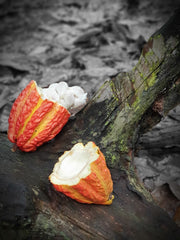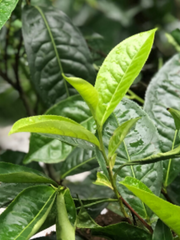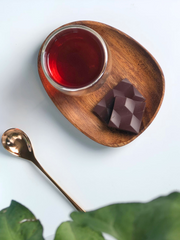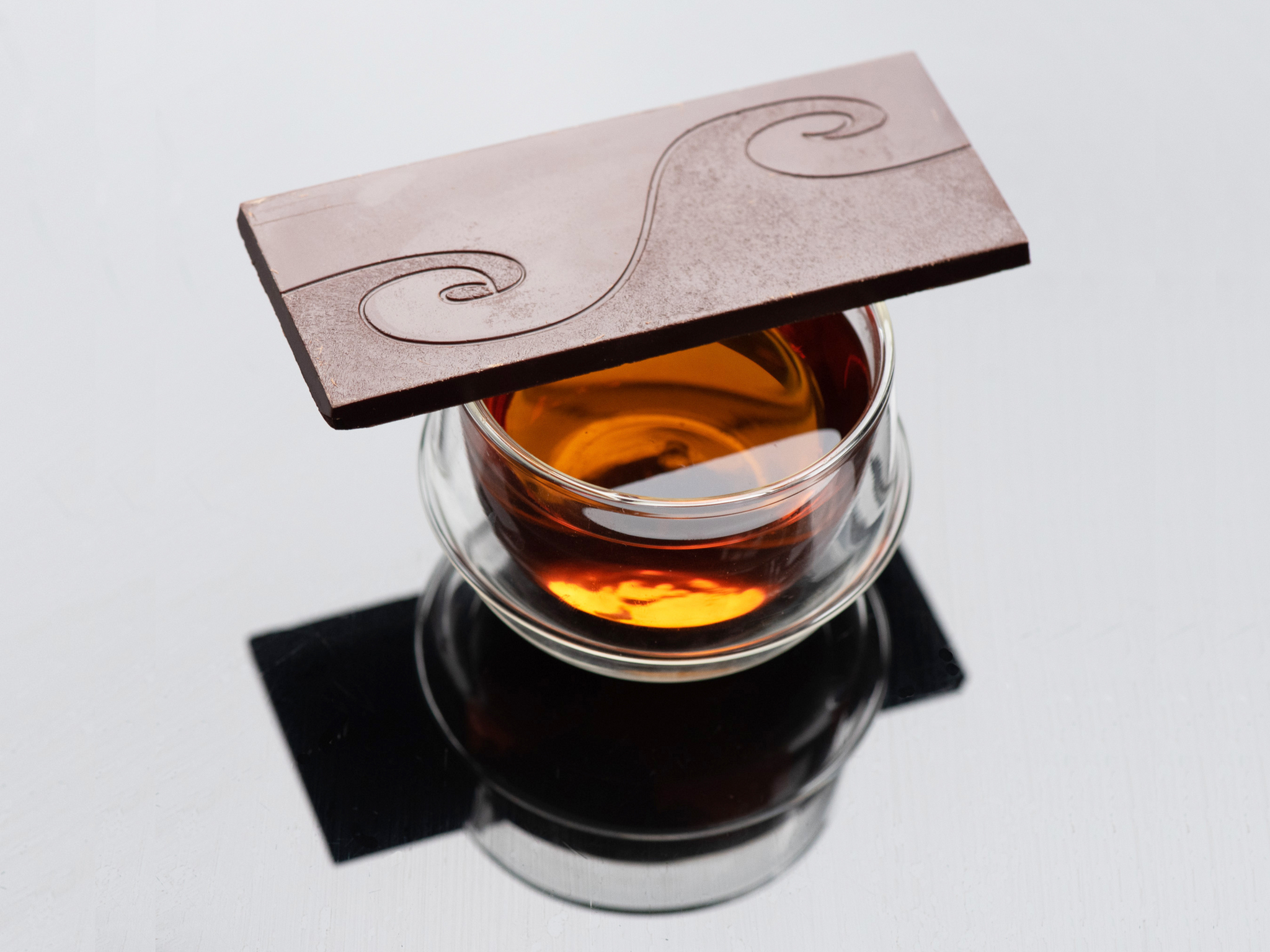Tea and chocolate: the perfect partnership
Written by Luke Owen Smith
It may surprise you to find an article about chocolate on a tea website, but tea and chocolate have an incredible amount of things in common. From history, culture and ethics to flavours, processing methods and ceremonial presentation, there are fascinating links and similarities everywhere you look. Plus, tea and chocolate are the perfect tasting partners, as you’ll soon discover…
It all starts with cacao
First things first, we need to differentiate between chocolate and cacao. Cacao is the main ingredient of chocolate and it bears very little resemblance to the  sweet brown blocks of confectionery that most of us grew up eating. Cacao is a tropical fruit that grows all around the world, within a belt that spreads roughly 20 degrees north or south of the equator (tea can grow in much colder conditions - we even have a tea plantation here in New Zealand!). Cacao fruit ‘pods’ are shaped a little like rugby balls and come in a variety of colours - usually red, orange, yellow or green, depending on the genetic varietal. Inside these pods are around 20-50 seeds (known as cacao beans), surrounded by a bright and juicy fruit pulp that tastes sweet, tart and distinctly tropical.
sweet brown blocks of confectionery that most of us grew up eating. Cacao is a tropical fruit that grows all around the world, within a belt that spreads roughly 20 degrees north or south of the equator (tea can grow in much colder conditions - we even have a tea plantation here in New Zealand!). Cacao fruit ‘pods’ are shaped a little like rugby balls and come in a variety of colours - usually red, orange, yellow or green, depending on the genetic varietal. Inside these pods are around 20-50 seeds (known as cacao beans), surrounded by a bright and juicy fruit pulp that tastes sweet, tart and distinctly tropical.
Cacao and tea have both been cultivated and consumed for over 4,000 years, but up until the mid-19th Century, cacao was only ever made into a beverage. When the Spanish invaded the Aztecs of Mesoamerica in 1519, they discovered that cacao was highly revered, used as currency, and considered a gift from the gods. The Spanish promptly transported ship-loads of cacao beans to Europe, where wealthy nobility developed a taste for hot drinking chocolate (in a more rustic form than what we enjoy today.) For almost a century, drinking chocolate was the most popular hot beverage in Europe, but it was usurped by the introduction of tea and coffee in the 1700s. It wasn’t until 1847 that Fry & Son in England invented the first edible chocolate bar, so the culture of eating chocolate is at least four millennia younger than the culture of drinking tea.
How chocolate is made
Much like tea leaves, cacao beans go through a series of processing stages on their way to becoming chocolate, and each stage can be manipulated in various ways to affect the final flavour. Whereas oxidation time is the biggest variable in tea production, fermentation is the most important step in producing high quality cacao. The length of time tea is oxidised for can vary greatly, depending on the desired effect, but most cacao is fermented in the same way, with one main goal; well-fermented beans that are consistent in flavour and colour, contain the right amount of acidity, and display no common defects. Whilst some modern fermenters are starting to push boundaries and question what ‘good’ or ‘bad’ cacao fermentation looks like, there’s a lot less variation than with tea oxidation.
Cacao beans are fermented and dried shortly after harvesting - usually on the farm or at nearby fermentation facilities - and then shipped to distributors and chocolate makers around the world. At this point we see a big difference between the journey of tea and cacao; once tea has been processed it’s ready to be brewed, but cacao goes on to another complex stage of production, in order to be transformed into chocolate. Chocolate makers work through a series of steps, including roasting the beans, removing the shells, grinding the inner ‘nibs’ into a liquor (essentially liquid chocolate), refining the particle size, conching (mixing at speed with heat applied), and tempering (ensuring the right crystal structures form). Throughout these stages there are many different ways that chocolate’s flavour can be manipulated, particularly when it comes to roasting and conching times.
Due to their relatively late invention in the mid-19th Century, chocolate bars  have almost always been made on a large industrial scale. Until recently it was considered too difficult and expensive to make chocolate on a smaller scale, but in the past twenty years we've seen the emergence of the craft chocolate movement, which started in North America and has now turned into an international renaissance. Craft chocolate makers are challenging the status-quo of the industry by making chocolate from scratch - from ‘bean to bar’ - in comparatively tiny batches, using rare and specialist varietals of cacao. Although still in its early stages, this movement has totally transformed people’s perceptions of what chocolate can be, and there’s a quality of chocolate being produced today that has never been seen before.
have almost always been made on a large industrial scale. Until recently it was considered too difficult and expensive to make chocolate on a smaller scale, but in the past twenty years we've seen the emergence of the craft chocolate movement, which started in North America and has now turned into an international renaissance. Craft chocolate makers are challenging the status-quo of the industry by making chocolate from scratch - from ‘bean to bar’ - in comparatively tiny batches, using rare and specialist varietals of cacao. Although still in its early stages, this movement has totally transformed people’s perceptions of what chocolate can be, and there’s a quality of chocolate being produced today that has never been seen before.
Most of the world’s chocolate is made with cheap commodity cacao that is very heavily processed, resulting in bars that usually taste monotone and ‘chocolatey’. Many people think of ‘chocolate’ as one specific flavour or smell, but it’s only one potential flavour note in a vast spectrum of delights. By sourcing heirloom cacao varietals and lightly processing them with copious amounts of time and care, craft chocolate makers are creating chocolate with a lot more depth, nuance and complexity. This is chocolate to be tasted slowly and consciously, just like a good cup of tea, and as you build up experiences and train your palate, it’s possible to discover flavour notes like fruity, floral, nutty, roasty, herbal, spicy, earthy, sweet, and many many more. If that all sounds familiar to you, it’s because the potential flavour spectrum of specialty tea and high quality chocolate is almost identical.
The quality and ethics spectrum
Whilst tea and chocolate have some exciting and delicious parallels, they also share some of the same challenges and issues. High quality tea is well-appreciated in places with ancient tea traditions, such as China or Japan, but in Europe, North America and Oceania, cheap black tea (known as CTC - Crush, Tear, Curl) dominates the market. Along with this culture comes a surprising lack of awareness of what tea actually is (the plant, Camellia Sinensis) and where it  comes from. Exactly the same is true of chocolate - very few people associate the brown, sweet blocks on the supermarket shelf with a tropical fruit, and what most people think of as chocolate would more accurately be described as cocoa-flavoured sugar and fat.
comes from. Exactly the same is true of chocolate - very few people associate the brown, sweet blocks on the supermarket shelf with a tropical fruit, and what most people think of as chocolate would more accurately be described as cocoa-flavoured sugar and fat.
This disassociation from raw ingredients can cause a lack of awareness of ethical issues. Both tea and cacao were taken to Europe by colonists who often used brutal methods to set up trading structures that were deeply unfair and rooted in racism. Shockingly, these trading arrangements are still widespread today, and issues of poverty, slavery and illegal child labour are still found on some tea and cacao plantations. Whilst tea and chocolate lovers around the world are gaining more understanding of these issues, and learning how to support ethical producers, there’s still a long way to go with educating the public and changing consumer habits. Most of us grew up with tea and chocolate that was simply much cheaper than it should have been, predominantly because the growers were treated badly, and it seems the only way to change this system is to completely reassess pricing models and trading structures. Unfortunately, mainstream-industrial tea and chocolate companies seem unwilling to make such changes.
The beauty of chocolate and tea pairing
Understanding all of this can be disconcerting - to say the least - but it can also deepen one’s appreciation of trustworthy producers and suppliers that offer high quality, ethical and specialist tea and chocolate. Discovering the best of these two worlds is truly life-enriching, and learning how to enjoy them together can be a rewarding and revelatory experience. The two pair incredibly well because they offer a similar spectrum of subtle and complimentary flavour notes that won’t overpower each other, and the right pairing will elevate and emphasise these flavours, resulting in a tastebud adventure that is greater than the sum of its parts.
Because tea and chocolate pair so well, finding a good match is surprisingly easy, particularly when you stick to high quality products. To start with, you could try pairing things with similar tasting notes (i.e. a fruity chocolate with a fruity tea), and then you can try finding complimentary flavours (i.e. a salted chocolate with a nutty tea). A good initial guideline is to pair lighter tea with lighter chocolate and darker tea with darker chocolate, but this definitely isn’t a golden rule. Play around with different combinations and over time you'll discover some sensational pairings that transform your level of appreciation.
Often chocolate is eaten quickly - like a snack - but for this exercise you want to slow everything down and be as conscious as possible, savouring the chocolate in the same calm way that you appreciate your cup of tea. When you’re ready to begin tasting, first have a sip of tea and then put a piece of chocolate in your mouth. The tea will warm your mouth and cause the chocolate to melt faster, thus releasing its flavours more intensely and creating a sensory explosion. Roll the chocolate around your mouth and tongue as it melts and notice how the flavour develops over time - we call this the flavour journey. Next, have another sip of tea and see how it differs from your first sip, then go back and forth between the tea and chocolate as many times as you like. It can be fun to take notes throughout this process, so that you remember your favourite combinations.
Here are a few recommended pairings, with suggested chocolate bars that you could try. You should be able to source these bars online or in specialty supermarkets and delis, but if not, there are plenty of other bars to choose from. Ask your local craft chocolate dealer for advice if you’re not sure what to buy.
Floral white tea with bright and floral single origin dark chocolate
Suggested bar: Shirl & Moss - Kilombero Valley, Tanzania 70%
Jasmine tea with single origin white chocolate
Suggested bar: Lucid Chocolatier - 34% Blonde
Malty/nutty dark oolong tea with dark-milk chocolate
Suggested bar: Raglan Chocolate - Milk Chocolate 54%
Hojicha (roasted green tea) with a salted dark chocolate
Suggested bar: OCHO - Salted Caramel
Fruity black tea with a fruity dark chocolate
Suggested bar: Foundry Chocolate - Anamalai, India 70%
Pu’erh (dark) tea with high percentage dark chocolate
Suggested bar: Hogarth Chocolate - Ecuador 85%
When it comes to pairing high quality tea and chocolate, the key is letting the natural flavour of the raw ingredients shine. This is about showcasing specialty cacao and tea varieties, preserving unique terroir, and appreciating exceptional craftsmanship, so keep things simple and focus on single origin tea and chocolate without unnecessary additives. It’s astonishing how these little leaves and beans contain vast galaxies of flavour, and even more exciting to discover the areas where these galaxies overlap. Why is there tea with natural chocolate notes and chocolate with natural tea notes? And why can these unrelated plants, which originate from different sides of the world, both end up tasting like apricots, cinnamon, toffee or any number of things? One might suggest it points to the essential unity of all life on earth - a little nod from Mother Nature, to let you in on a beautiful secret. But maybe it’s better to just marvel at the infinite mystery of it all, without a need for answers. Whatever the case, it’s definitely something to contemplate while you wait for the kettle to boil, and a lovely thing to discuss when tasting with friends or family.
So what are you waiting for? Start planning your first tea and chocolate tasting today and begin your exploration of these parallel cultures. You have some delicious epiphanies ahead of you.
~ Luke Owen Smith

About Luke: Luke is a professional chocolate taster, craft chocolate judge, and founder and former owner of The Chocolate Bar. He loves great food and great people and immerses himself in both on a daily basis. He is now a journalist, photographer and marketer for small businesses.
Follow Luke on instagram
Credits:
Header image by Luke Owen Smith
Cacao fruit image by Larry Garcia Pezo on Unsplash
Chocolate bar, cacao beans and nibs image by Tetiana Bykovets on Unsplash
Camellia Sinensis plant image and chocolate and tea image by Anna Kydd
Join me and build your tea and wellbeing wisdom
If you would like to improve your tea and wellbeing knowledge, sign up to my mailing list below (underneath the comments form). I'd love you to join my community.


